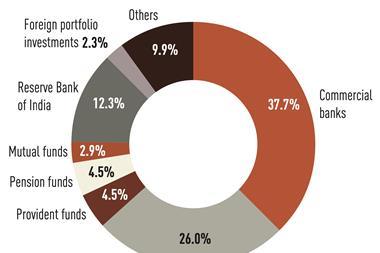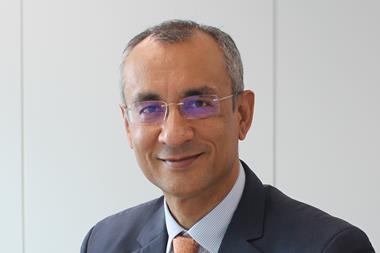Whisper it quietly, but there is a place on the credit spectrum that delivers a better risk-adjusted return than anywhere else. The bonds world calls it ‘crossover’: those credits lingering at the very bottom of investment grade (BBB-) down to those at the top of high yield (BB).
Lombard Odier has analysed Barclays Capital figures from 2003 to 2010 to reveal that while investment grade (IG) and crossover shared similar volatility (3.5%), crossover delivered a return of 5.39% versus IG’s 4.09%. European high yield delivered 8.18% returns from 9.16% volatility over the same period. In terms of Sharpe ratio that translates to 0.89 for HY, 1.27 for IG and 1.52 for crossover.
“The ‘5Bs’ universe is not a niche,” Lombard Odier’s fixed income and currencies CIO Stephane Monier, says. So why is it such a good place? If you are benchmarked against an IG index, your BBB- names face the constant threat of being downgraded and dropping out. You might have a 10% HY ‘bucket’, or perhaps some leeway to hold the bonds for 90 days, but ultimately you will have to sell. And if you are benchmarked against a HY index, being overweight lower-yielding BB names is not the way to outperform that index.
This is where that extra yield per unit of risk comes from: it is a liquidity premium paid for filling the gap between IG and HY. Crossover investors can be paid that premium to own some high-quality names, whether ‘rising stars’, or ‘fallen angels’. Moreover, Crossover’s nice mix of mutually diversifying credit and duration risks leads to a changing liquidity profile through the credit cycle. Currently, IG portfolios are dipping into crossover searching for yield, while HY portfolios are moving down towards single-C. Crossover investors get a liquidity discount from the HY investors for ‘rising stars’, which they can cash in using the liquidity coming from IG investors. In a recession, IG investors flee to AA names, leaving a liquidity discount on ‘fallen angels’ and low-rated credits for crossover investors, which they can cash in using the liquidity coming from HY investors moving up into BBs. Of course it’s not quite as simple as that: there tends to be a 3-6 month lag before the spreads at which IG offers become the spreads at which HY bids - which is why crossover investors get paid that premium.
“Behavioural finance will tell you that the day before that happens, you’ve sold because you’re terrified,” says Martin Reeves, director of global credit research at AllianceBernstein. “You’ve got to be able to live with the pressure of the price going down.” Bottom-up fundamentals are therefore important in crossover. Price action can make all ‘fallen angels’ look bad - and many will indeed be value traps. “Fallen angels have roughly 50% greater probability of being upgraded than the typical high yield name,” says Peter Greatrex, head of research at Blue Mountain Capital. “But they also have a greater probability of default.”
‘Rising stars’ present their own risk, too. Finance officers for fast-growing, cash-generative business have good reason to sweat balance sheets in a way that may not be compatible with BBB metrics, and these incentives are even stronger during an upturn when spreads between BBs and BBBs compress. Telecoms and healthcare provide many examples, and building materials in the US. “Every time Fresenius’ metrics begin to look like BBB they re-lever,” observes Jonathan Butler at Pramerica Investment Management.
Some firms, particularly in the US, will go so far as to acquire a lower-rated competitor to re-leverage. This points to another risk in crossover: M&A. Because many names are value plays they become acquisition targets. Mirko Santucci, head of credit at Swisscanto, recalls buying Chespeake Energy three weeks before its shale gas assets were bought by BHP Biliton. But he also admits that his only crossover position that turned sour was Axcan Pharma, downgraded from BB- to B+ after making an acquisition. Also, being acquired by BHP Biliton has a different effect than being acquired by private equity.
“This emphasises the importance of spending time on the structural elements, such as which bonds are subject to change of control language,” says Greatrex. “The performance of different instruments can diverge dramatically for a given event.”
So the premium crossover pays seems related to the liquidity that investors must forego in the face of these risks. Investors must therefore understand how the liquidity profile
of crossover might be changing. Most notable is the increasing flexibility of IG mandates to hold HY. This is limited and slow-moving but nonetheless one might see the paltry 5% yield on offer from BBs as evidence of more activity there from flexible IG funds, or the fact that building materials firm Lafarge does not seem to have suffered a rejection by worried IG investors despite teetering on the margins of BBB-.
There is a devil in the detail: Edward Farley at Pramerica notes that the Lafarge bond with ‘step-up language’ has outperformed recently - but the overall point seems fair. Some companies - Fiat, HeidelbergCement, Continental, perhaps soon Lafarge - are essentially IG names rated at BB. “Investment grade accounts would probably hang on to these and ride the whole cycle,” as Hans Stoter, head of credit at ING Investment Management puts it. Which is why HY and crossover investors aren’t interested. This time there have been better alternatives: “In this cycle the fallen angels story has been all about subordinated financials,” says Steve Logan, head of European high yield at SWIP. The financial crisis saw a ton of this paper downgraded to junk, and HY investors have shunned it because they are not used to analysing sovereign and regulatory risk. Crossover investors get to take the liquidity discount from IG investors and wait for upgrades.
If you don’t like banks, high yield managers like Alexandre Caminade at Allianz GI Investments Europe point to the abundant supply of BB senior secured credits from single-B issuers, like Ardagh Packaging, Virgin Media and Uno Telecom, which took advantage of low rates to refinance and extend their maturities. The rates story suggests a third opportunity. While IG investors are increasingly holding on to their non-financial ‘fallen angels’, they may also begin to reach down for more credit risk as rates threaten to rise, providing liquidity for these financials, senior secured BBs and even single-Bs. There will come a point when rising rates will force HY investors to re-assess their lower-grade credits, too. “Where do you want to be in high yield when rates start to go up?” wonders Felix Martin, economist and analyst in the global credit team at Thames River Capital. “There is a long tail of firms whose EBITDA barely covers their interest payments.” Add all of this to the mountain of cash that HY funds got from investors in 2010, and we could see a migration into ‘5Bs’ as rates go up - Fiat Industrial’s four-times oversubscribed BB+ issue on 7 March suggests we already are.
However, all three of these phenomena - subordinated financials, senior secured BBs from single-B issuers, the bounce off two-years of low rates - are particular to this post-crisis cycle. Only the financials opportunity looks anything like the traditional ‘fallen angel’, and the potential drift up the credit spectrum by HY investors in a rising rate environment cuts across the usual crossover liquidity pattern.
So crossover looks like a great short-term opportunity. But will it remain the great long-term opportunity that it has been in the past? Its liquidity profile is changing, slowly but surely. Investors need to ask what that means for the premiums on offer there.






























No comments yet